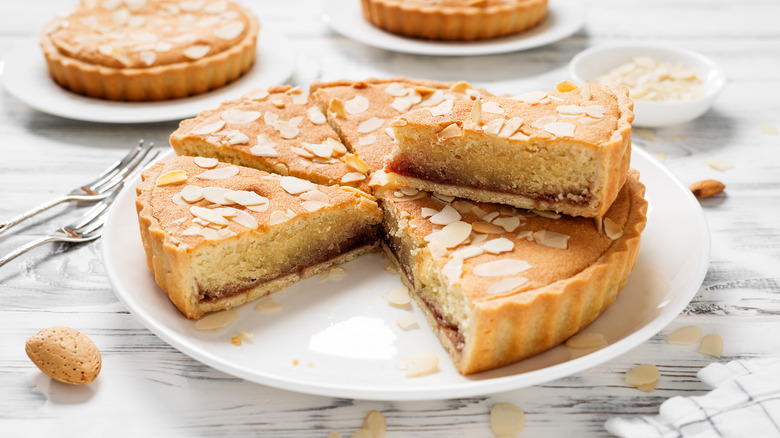How Did The Bakewell Tart Get Its Name?
A decade ago, unless you had traveled to England, you might not have heard of a Bakewell tart. But that all changed as the "Great British Bake Off" crossed the pond to become a cultural phenomenon in the United States, where it is referred to as the "Great British Baking Show." The beloved cooking challenge has introduced Americans to a host of delicious British baked goods and confused stateside audiences unfamiliar with the specifically British use of terms like biscuit and pudding. The seemingly generically-named Bakewell tart itself has been among the most frequently baked treats on the show, popping up in one form or another across many of the show's seasons.
Bakewell tarts can be made with a number of variations, but according to MasterClass, the basic Bakewell is a shortcrust pastry filled with jam, usually raspberry, and frangipane, and garnished with sliced almonds. The end result is an indulgent slice of buttery and sweet almond pastry, cut slightly by the tangy jam. It is a simple, but elemental flavor combination that lends itself to all kinds of baked goods besides tarts, including sweet rolls and cakes.
While the dish is popular throughout Britain, its origins, and the source of its name, can be traced back to one specific corner of the country.
Bakewell tarts trace their history back to the town of Bakewell
Bakewell might sound like it's named after the act of cooking itself, but Bakewell is actually a historic town in Derbyshire, England. According to Tina's Traditional the Bakewell tart got its name from a different treat named after the town: Bakewell pudding. The original pudding was created sometime in the early 19th century and uses egg custard on top of the jam instead of frangipane, getting its almond flavor from icing that covered the custard. The Oxford Companion to Food says the local legend in Bakewell is that the pudding was created by mistake by a cook at the town inn. However, because the pudding was already known in the area, the publication noted that the fable seems unlikely.
It is unclear where the tart version originated from, but it took its flavor cues from the pudding, thus becoming the Bakewell tart. By the late 19th century, the most prevalent recipes for the pudding had already become closer to the modern day tart, with the shortcrust version we know today appearing in the 1900s, per Tina's Traditional. The Bakewell tart, or pudding, has since grown so popular that the town of Bakewell has become a tourist destination, attracting lovers of the dessert from all over the country.
While traveling there might be a bit of a stretch for American fans, we hope that the growing recognition of the Bakewell tart on this side of the Atlantic makes it an increasingly common sight at bakeries closer to home.

